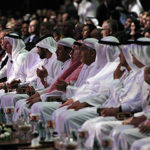
At the Annual Meeting & Exhibition of the International Society for Magnetic Resonance in Medicine (ISMRM), attendees are going to see the world. Focusing on cutting-edge practices and research related to the use of MRI, the conference rotates around the globe every four years — from Asia to Europe to the Americas.
A big part of the program is delivering an authentic local experience attendees couldn’t have anywhere else. At ISMRM 2016, which was held at the Suntec Singapore Convention & Exhibition Centre from May 7–13, that meant designing a closing party that imprinted the steamy Asian metropolis and its local culture in the minds of the 5,200 attendees. Hospitality students ended up being the key.
‘A LOVELY WIN-WIN’
In Singapore, there’s nothing more authentic than hawker centers — open spaces where individual restaurant stalls ply dishes like black-pepper crab, barbecued stingray, and kidney soup. On the last day of ISMRM 2016, thousands of attendees walked to Makansutra Gluttons Bay, one of the city’s best-known hawker centers, to sample street food, listen to a local band playing in an adjacent amphitheater, and visit nearby open-air bars.
ISMRM rented out the entire Makansutra center for the event, something the city had never allowed before, according to Roberta A. Kravitz, ISMRM’s executive director. “For attendees who go to the meeting every year, the closing party really becomes important to give them placement,” Kravitz said. “We wanted something that was very Singapore.”
And they got it — thanks to some “very Singapore” partners, including East West Planners, a local destination management company. In the months leading up to ISMRM 2016, Janet Tan-Collis, East West’s founder and chief executive, reached out to the hospitality program at Singapore Polytechnic, and worked to create a project around the meeting within one of the school’s courses. Tan-Collis met frequently with a cohort of 108 second-year students, challenging them to propose ideas and solutions to pull off this type of event.
The students scouted locations, wrote proposals, and researched the pacing of the event and the positioning of volunteers. Then they volunteered at the party themselves, doing everything from guiding guests to helping with crowd control. “They got to see the whole concept come together and could understand it fully,” Tan-Collis said. “It wasn’t just academic.”
The hospitality students’ involvement helped provide attendees with authentic Singapore interactions. It saved ISMRM a significant amount of money. And, Tan-Collis said, it helped the students understand the level of detail and planning it takes to run such an event. “It was a lovely win-win,” she said.
STUDENT LEADERS
The result was a well-thought-out walking route from Suntec to the waterfront Makansutra, with students — wearing distinctive black Singapore Polytechnic t-shirts — serving as escorts for the 3,500-attendee crowd. Much of the route wound through air-conditioned underground malls to avoid the humid weather. Lines for food at the hawker stations were initially long, Kravitz said, but with the help of the students, the entire crowd was fed in an hour-and-a-half.
From 6:30 until 11 p.m., the space was the exclusive playground of ISMRM attendees, who danced, watched fireworks over the water, and, of course, tried the many local dishes. In planning for the possibility of bad weather, ISMRM debated tenting the open-air market, but the cost would have been exorbitant. Instead, they ordered 4,000 ISMRM-branded umbrellas and kept them on hand in case attendees needed them. They didn’t — it never rained.
As with any well-planned event, an unseen amount of effort went in to making it appear effortless, Tan-Collis said. That included several weeks of site inspections by students and East West Planners, as well as by ISMRM staff. Because Singapore had never rented out Makansutra Gluttons Bay before, city officials were skittish about the idea. Tan-Collis drew on years of professional relationships and friendships, plus her local reputation. She had to nail down permits, licenses, and security details.
“I had to have a number of meetings and sit-downs, because [city officials] had their reservations and questioned me,” Tan-Collis said. “Based on the solutions I was able to provide, they gave me 100-percent support.”
In an international city like Singapore, Tan-Collis recommends hiring an experienced local DMC or PCO. This event “was not something one can book as if it was a commodity,” she said. “Everything had to be designed and crafted. I don’t think something like this could be done if you didn’t have someone local on the ground.”
LASTING IMPRESSIONS
 Each year, the ISMRM Annual Meeting tries to evoke the culture of its host country at the closing party. In Stockholm in 2010, ISMRM hired an ABBA cover band called Waterloo, hung a disco ball from the ceiling, and put most of its party funds into stocking the bar and serving great food. “There were 3,500 nerdy guys with their iPhones in the air,” said Kravitz. “The place was going crazy.”
Each year, the ISMRM Annual Meeting tries to evoke the culture of its host country at the closing party. In Stockholm in 2010, ISMRM hired an ABBA cover band called Waterloo, hung a disco ball from the ceiling, and put most of its party funds into stocking the bar and serving great food. “There were 3,500 nerdy guys with their iPhones in the air,” said Kravitz. “The place was going crazy.”
In Berlin in 2007, the closing party was held in an authentic performance hall from the 1950s, with spiral staircases and doors opening onto a patio and a pond. ISMRM hired a local swing band, went all out on German food, and surprised attendees with a comical newscast created during the convention when a “news reporter” interviewed members about MRI technology.
In Milan in 2014, ISMRM recreated an Italian street scene in an exhibit hall, serving up local dishes — including gelato — and hiring a local band that played while sitting inside a psychedelic 1960s Volkswagen bus parked right on the show floor.
In each case, using local entertainment and spending money on food and drink rather than décor helped make things memorable without breaking the bank. Even without a fat wallet, Kravitz said, “we do what we can to leave a lasting impression.”



